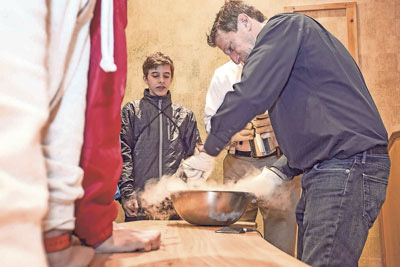PLAINSBORO — Fifty seventh and eighth graders from John Witherspoon Middle School in Princeton came to PPPL for a half day on March 4 to become scientists — doing a variety of hands-on science activities, from building a motor to sampling ice cream frozen with liquid nitrogen in a cryogenics demonstration, to watching cool plasma demonstrations of lightning, static electricity and stars.
They left wanting more.
The activities, organized by PPPL’s Science Education staff, were designed to spark students’ interest in STEM (science, technology, engineering, and mathematics). The program was one of many National Week at the Labs events taking place Feb. 29 to March 4 at more than 50 national laboratories across the country with more than 5,000 students.
The initiative was part of President Obama’s My Brother’s Keeper (MBK) program, which aims to support and inspire boys and young men of color to succeed in school and go on to college and successful careers. The MBK recently announced MBK STEM and entrepreneurship tracks to encourage young men in those areas. Princeton is one of the towns participating in the program.
Seventh grader Delmos White gave the morning’s activities rave reviews. “It was awesome,” he said. “I like how we did experiments.”
The middle-schoolers heard a recorded greeting from U.S. Energy Secretary Ernest Moniz and then broke up in three rotating groups for science activities. One group spent an hour in the Science Education Laboratory learning to build circuits, motors and electromagnets. Another took part in a cryogenics demonstration, while a third group participated in hands-on plasma activities.
Plainsboro Deputy Mayor Neil Lewis attended the event.
“I’m so proud that PPPL could be part of President Obama’s initiative through the local Princeton My Brother’s Keeper program and through National Laboratories Week,” said Head of Science Education Andrew Zwicker. “We know that middle school is a critical time to get students interested in science and engineering careers and the best way to do that is with the hands-on program we’re doing here today.”
The group building electronics seemed to delight in making first a light bulb and then an LED light up with their circuits. They later made copper wire spin around with their electromagnets.
“It was fantastic,” said Science Education Program Leader Shannon Greco, one of the organizers, who led the workshop with Senior Program Leader Arturo Dominguez. “They were really engaged. We planned these activities with high-schoolers in mind and some of the middle schoolers did it faster than the high schoolers!”
Ms. Greco said she explained to the students making the electromagnets that the center stack of PPPL’s National Spherical Torus Experiment-Upgrade is also an electromagnet. “I said, ‘This is exactly what we do at the laboratory all the time.’ ”
The cryogenics demonstration was also a big hit. Mr. Zwicker and engineer Ray Camp showed the group how they could flash freeze hot dogs to make them as hard as stone. And making and eating ice cream using liquid nitrogen in what looked like an experiment by a mad scientist was one of the most popular things to do.
“I loved the ice-cream,” said eighth-grader Luis Munoz. “It was pretty good!”
Students lined up to make their hair stand on end when they touched the Van de Graaff generator, one of many plasma activities. They watched how a Tesla coil lit up a fluorescent tube. They particularly enjoyed watching marshmallows expand and then shrink in a vacuum chamber.
Princeton Public Schools science supervisor Eddie Cohen said the activities were “highly engaging.” “The students were excited to show their ideas and observations about experiments they’ve never seen before,” he said. “So I think the wow factor is very large here.”
Ms. Greco said she would like to see more activities in partnership with Princeton and other schools nearby PPPL. “We have that much more opportunity to really change the trajectory of their careers when there’s something this accessible to them,” she said.
Seventh-grader Delmost White, for one, sounded like he would welcome that opportunity. “It was amazing!” he said. “I want to come back a million times!”
PPPL, on Princeton University’s Forrestal Campus in Plainsboro is devoted to creating new knowledge about the physics of plasmas — ultra-hot, charged gases — and to developing practical solutions for the creation of fusion energy. Results of PPPL research have ranged from a portable nuclear materials detector for anti-terrorist use to universally employed computer codes for analyzing and predicting the outcome of fusion experiments.
The laboratory is managed by the university for the U.S. Department of Energy’s Office of Science, which is the largest single supporter of basic research in the physical sciences in the United States, and is working to address some of the most pressing challenges of our time.
For more information, please visit science.energy.gov.

